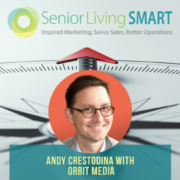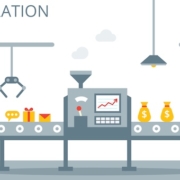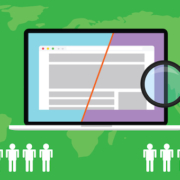Senior Living Advertising: Digital vs. Print
Digital and print can play nicely together in the same senior living advertising sandbox. But like anything else, there are pros and cons to each, which we discuss below.
Senior Living Advertising: Digital
What it is: When we say “digital” advertising, we’re referring to any paid advertising that happens online. This includes, but isn’t limited to the following:
- Google AdWords. Typically, people refer to AdWords as pay-per-click (PPC).
- Social media advertising. Particularly Facebook, but also Instagram, Twitter, and YouTube.
- Online banner ads. You tend to see banner ads on sites you browse, like media sites. Sometimes you buy these banner ads directly from the site itself; other times, your ads might rotate in via the Google Display Network.
- Google Display Network. As Google says, the Google Display Network is “a collection of over two million websites that reach over 90% of Internet users across the globe.”
- Remarketing. Have you ever browsed a site for a product, and then ads for that product followed you around on other sites? That’s remarketing at work.
- SMS marketing. In other words, text-based ads. The jury is still out on whether SMS marketing is a smart way to go, especially for our industry. We tend to think it can work better, at least right now, as a way for senior living communities to communicate with current residents and families (rather than as a way to advertise to prospects). But our position could change in the future.
Digital advertising can be considered inbound or outbound, depending on the medium. For example, PPC ads fall under the inbound marketing umbrella since you’re attracting people who are already doing searches for the product/service you’re selling. Same with remarketing ads.
The Display Network, however, falls under outbound. There’s no guarantee that the ads served up to you will be something you’re even remotely interested in or need. (Granted, your browsing habits will inform what ads get served, but some will most definitely be misses.)
Senior Living Advertising: Digital Pros
- Online advertising can often let you get incredibly granular. For example, you could focus your Facebook advertising on certain zip codes around your senior living community and only serve ads to women over 70 who still live in their own homes.
- You can get started with smaller budgets. Buying full-page color print ads can be incredibly pricey. With PPC, you can get a lot out of smaller budgets.
- You can change messaging/creative on the fly. Want to test a new message and see how it performs? Maybe switch up the images (“creative”) used in a campaign? No problem.
- You tend to have much deeper insights into an ad campaign’s effectiveness. Important analytics, like impressions, clicks, and conversions, are baked into the robust reporting.
Senior Living Advertising: Digital Cons
- It’s noisy out there, and people say they hate ads. In fact, according to this article, click-through rates are declining, more and more people are blocking ads through browser extensions, and for many, the ads have become a sort of background noise.
Senior Living Advertising: Print
What it is: Print advertising is just that—advertisements for your community that appear in printed formats like newspapers (local, regional, national); magazines (local, regional, national); directory listings; phone books; and billboards. We’re also going to include direct mail and brochures in this category as well. The difference between the two groupings is this: You pay a third party (like a newspaper) to run an ad inside its pages. With direct mail and brochures, you’re usually managing the creation and distribution of that collateral in-house.
Senior Living Advertising: Print Pros
- Your target market still reads print. Yes, older adults are big consumers of online media, but they’re still big consumers of print. According to this research, “25% of US adults aged 65 and over get their news from print publications.”
- Older adults think print is easier to read. According to the American Press Institute, “71 percent of those 65 and older like the ease of print.” Print-oriented readers also feel they get more news in print formats.
- Print could help boost word-of-mouth initiatives. Older adults like to share what they read in print, more so than their younger counterparts. “Sixty-three percent of print subscribers aged 65 and older share content compared with 58 percent of those aged 50-64, 49 percent of those aged 30-49, and 38 percent of those aged 18-34.” (Again, this is from the American Press Institute.)
Senior Living Advertising: Print Cons
- Ad buys tend to be pricier. If you want to run a full-page print ad, even in your smaller daily, it can add up. Plus, it’s a once-and-done sort of thing.
- Mistakes can’t be fixed. Oy! Print pieces are extremely unforgiving. If there’s an error, there’s not much you can do about it once it’s out in the world.
- You can’t easily experiment with messaging and creative. Once you sign off, it’s a done deal.
- Results can be harder to track. Sure, you can include an ad-specific URL or phone number to your print ad to help you track. But digital ad conversions tend to be more reliable.
Senior Living Advertising: Digital or Print? (Or Both?)
Earlier in this article, we shared stats about older adults and print formats, like newspapers. But older adults also spend time on digital devices. They own smartphones. They text. They’re on social media. They buy things off Amazon. They watch Netflix. They know how to use Google.
The American Press Institute backs this up with behaviors it sees between digital and print media subscribers: “Remember, 4 in 10 print subscribers still go to the website; 2 in 10 follow it on social media.”
This is precisely why we recommend to our clients that they use a mix of approaches when it comes to senior living advertising (while keeping in mind that these recommendations will evolve—we might be suggesting different strategies in 2030).
Tips for Successful Senior Living Advertising
- Know your budget. Make sure you’re not spending too much on any one advertising vehicle. A balanced approach is a smart approach, especially when you’re just getting started. Over time, as you see which ads deliver the biggest ROI, you can adjust your ad spend accordingly.
- Keep in mind all the “other” costs. The cost to run the ads themselves is just one cost. You also need to keep costs in mind for the creative (copywriting/design) and the cost you might pay to an outside vendor to manage your digital ad campaigns and/or your print media buys.
- Be honest about what your team can do—and what it can’t. We recommend using an outside consultant or agency (like ours) to manage your paid advertising. Unless you have someone on your team who is skilled (and ideally certified) in using Google’s ads program, it makes sense to hand the reins over to a professional.
- Track results as much as possible. Review analytics for digital campaigns and make adjustments accordingly. For print ads, offer ad-specific landing page URLs or ad-specific phone numbers with call-tracking software and monitor the results.
- Be prepared to let go and try new things. If you’ve been in this business a long time, it can be hard to let go of strategies that worked in the past. Trust the analytics and make decisions based on what the numbers are telling you.











